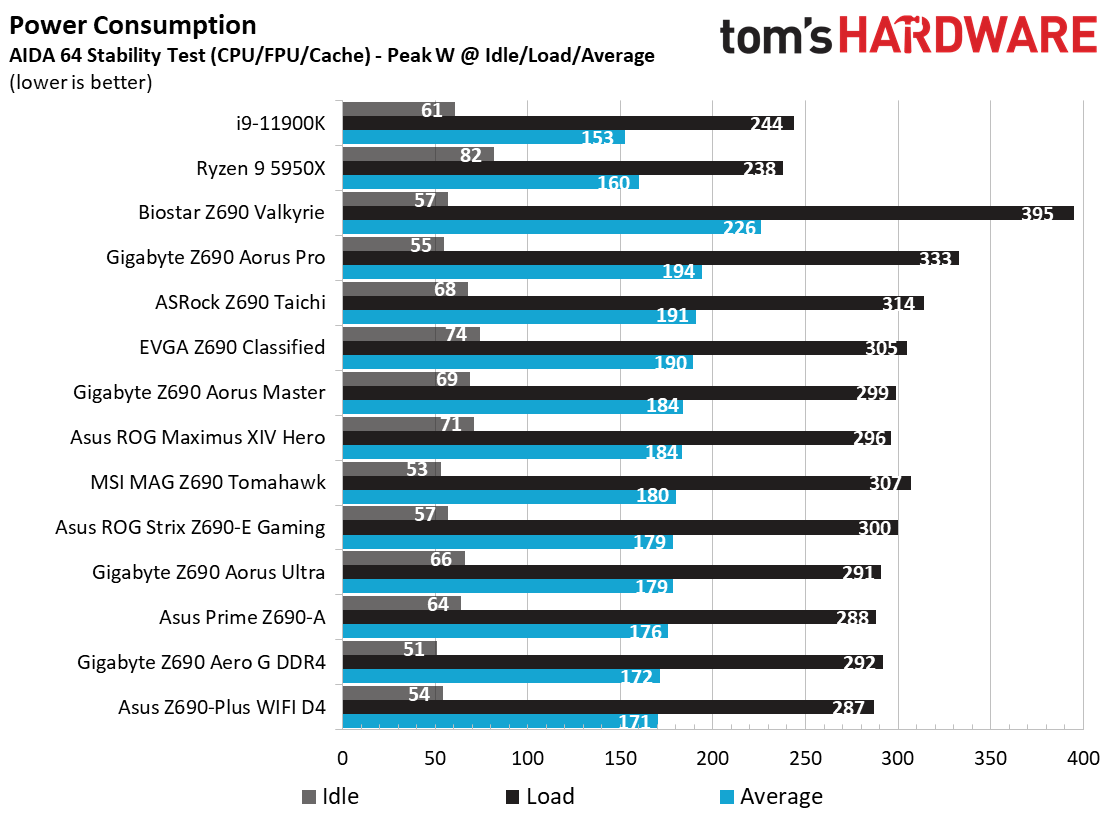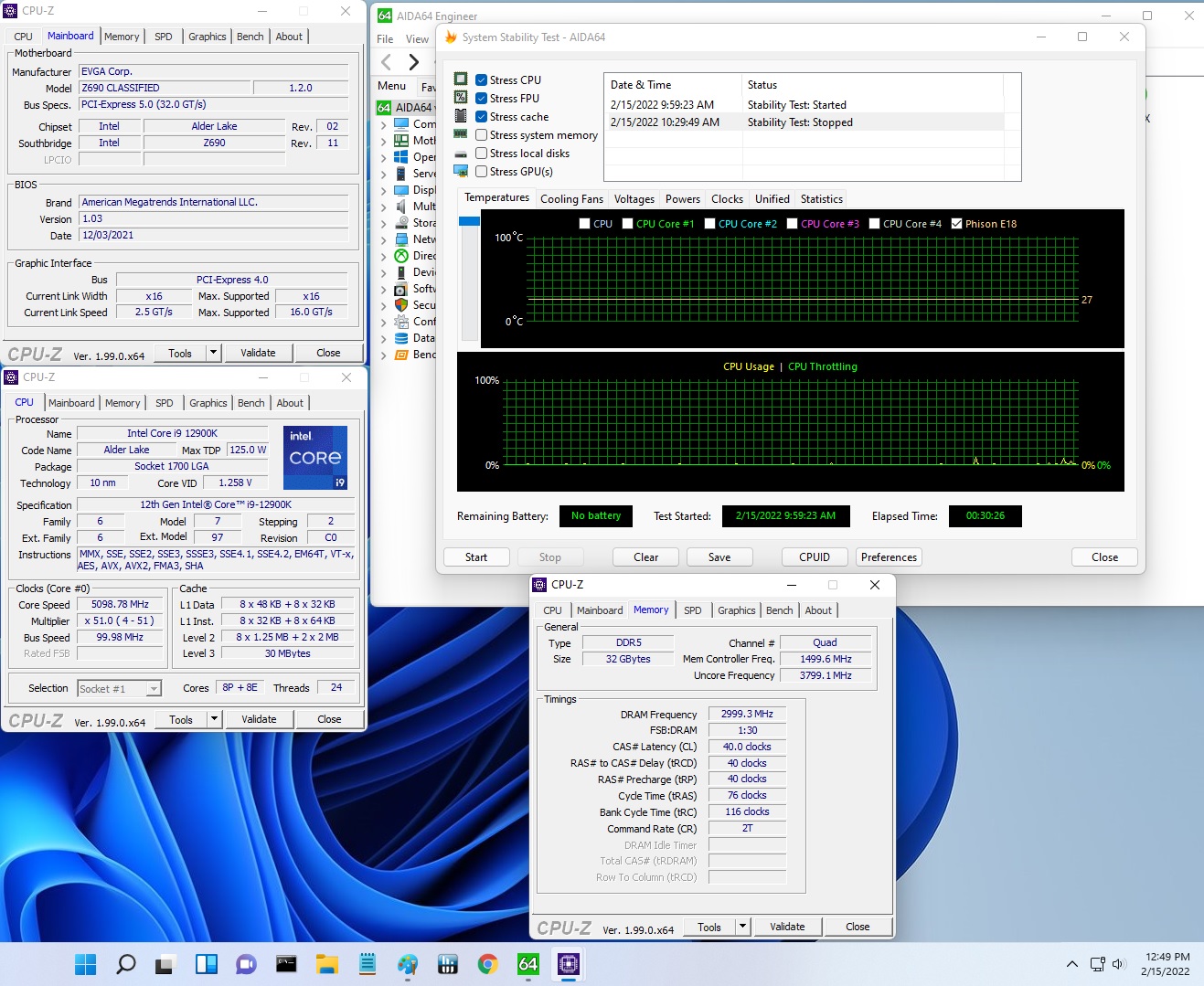Why you can trust Tom's Hardware
Benchmark Results and Final Analysis
Our standard benchmarks and power tests are performed using the CPU’s stock frequencies (including any default boost/turbo), with all power-saving features enabled. We set optimized defaults in the BIOS and the memory by enabling the XMP profile. For this baseline testing, the Windows power scheme is set to Balanced (default), so the PC idles appropriately.
To get the most out of the Intel Alder Lake chips, you need to be on Windows 11 with its updated scheduler. In most cases, Windows 10 performs well. However, some tests (Cinebench R20, Corona and POVRay) take a significant hit. In short, if you’re going with Alder Lake, you must upgrade to Windows 11 for the best results across the board. That may change with patching and updates in the future, though.
Synthetic Benchmarks
Synthetics provide a great way to determine how a board runs, as identical settings should produce similar performance results. Turbo boost wattage and advanced memory timings are places where motherboard makers can still optimize for either stability or performance, though, and those settings can impact some testing.
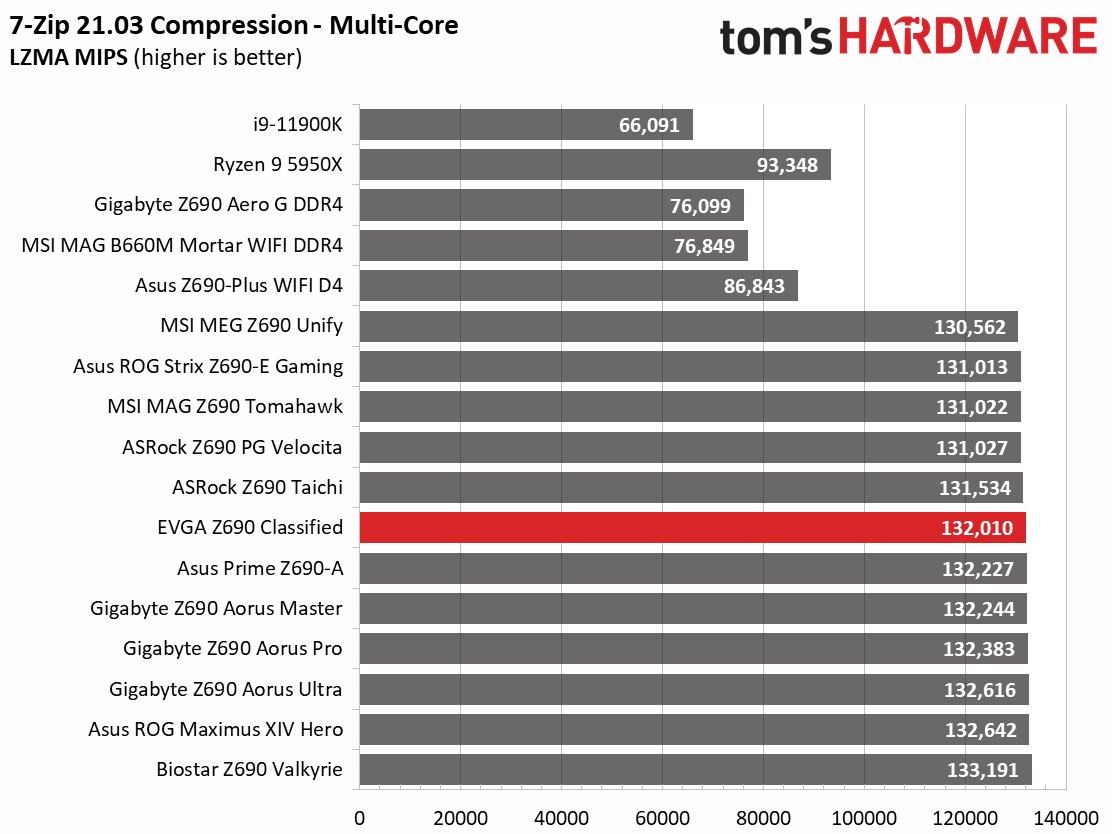
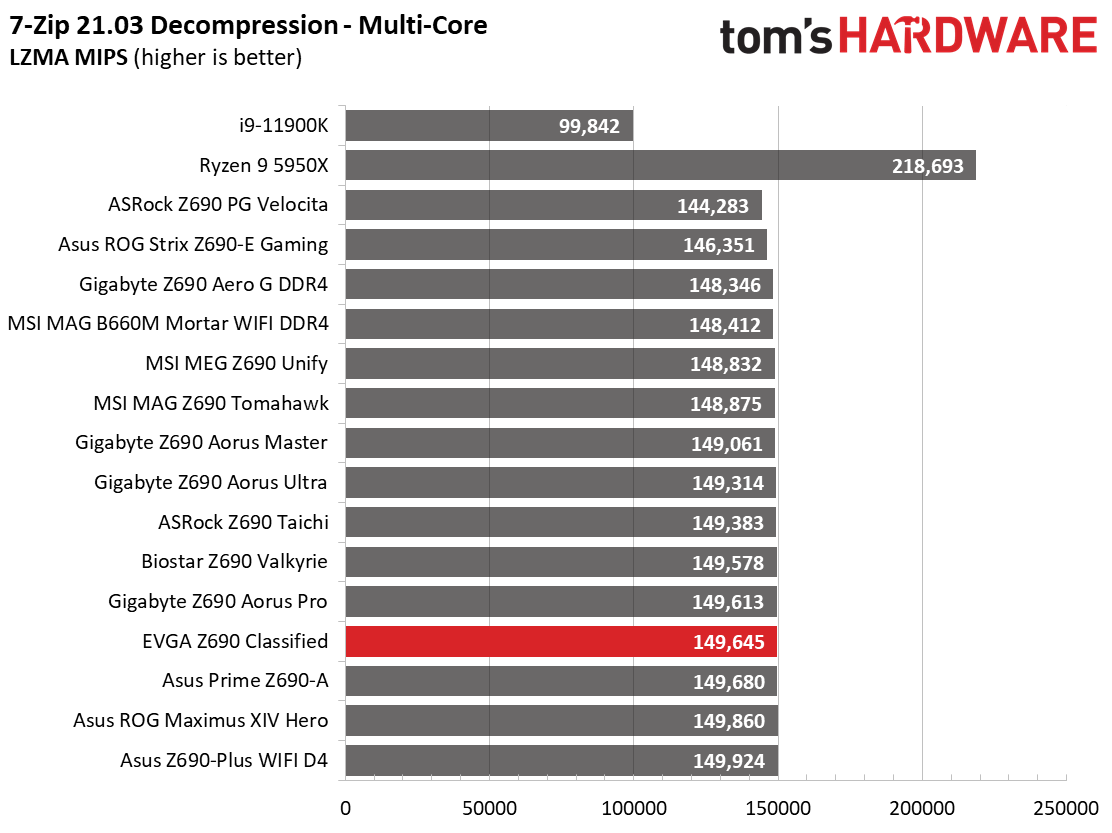
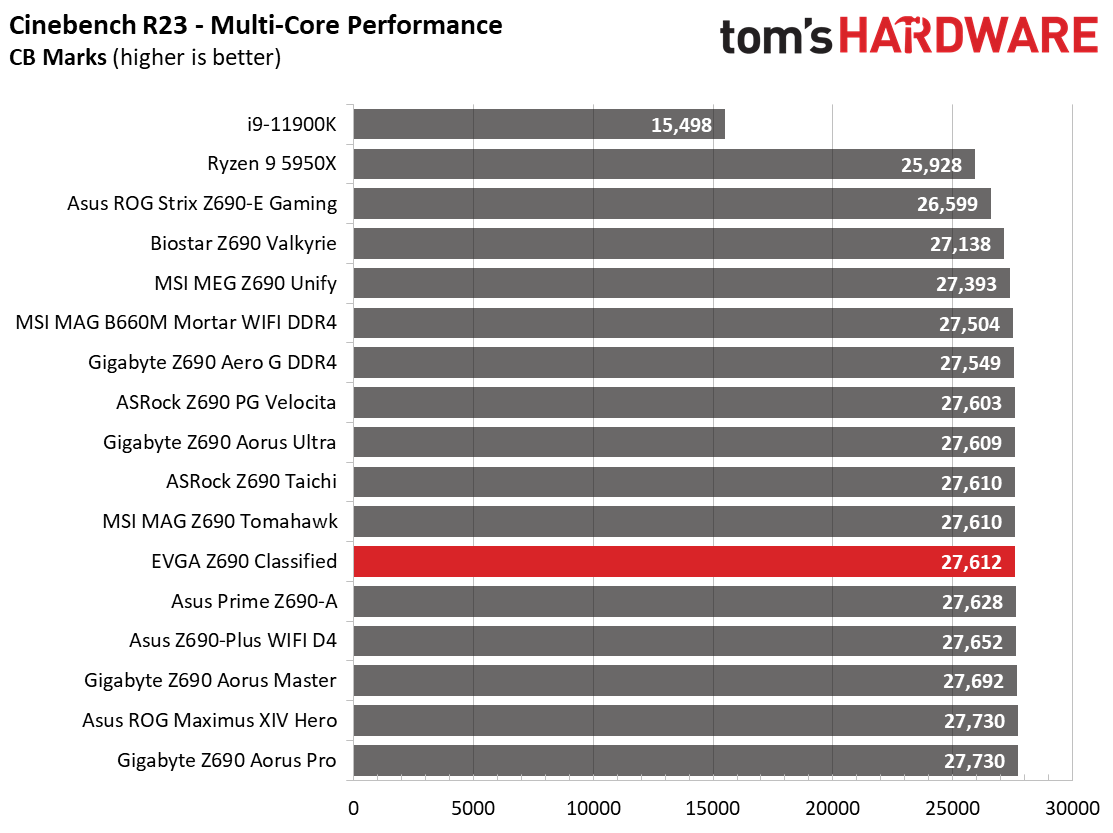
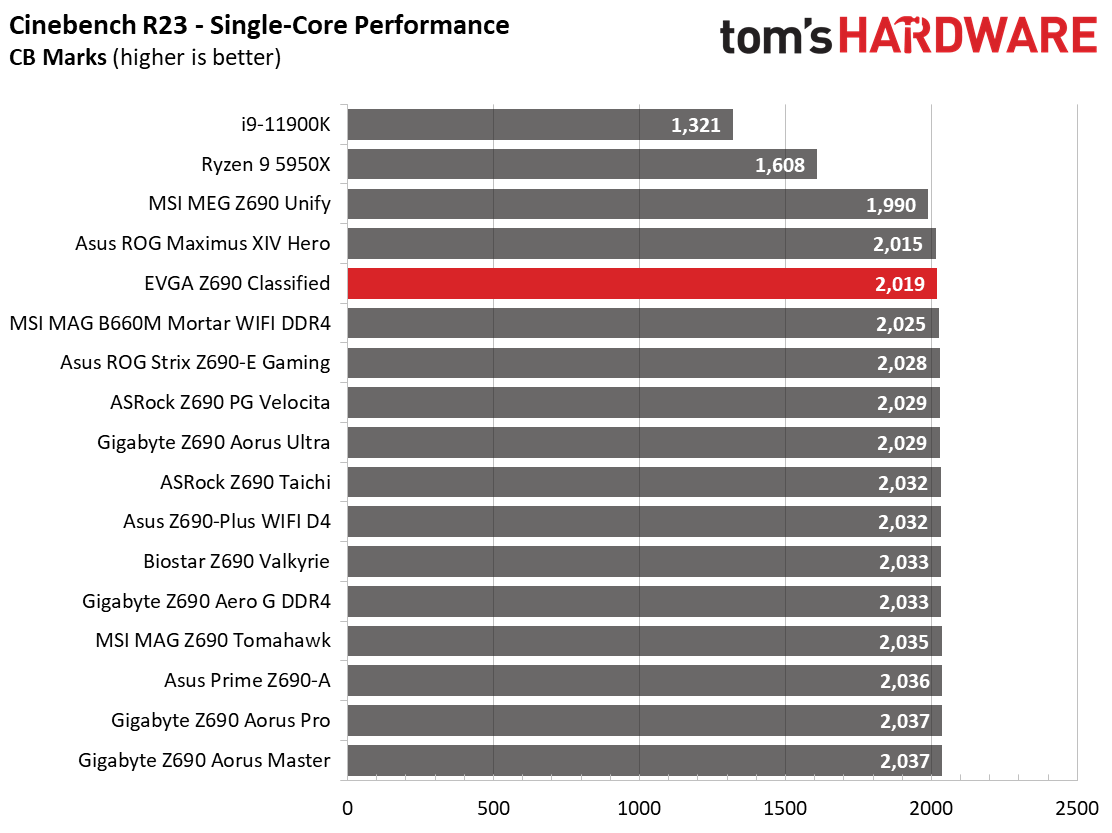
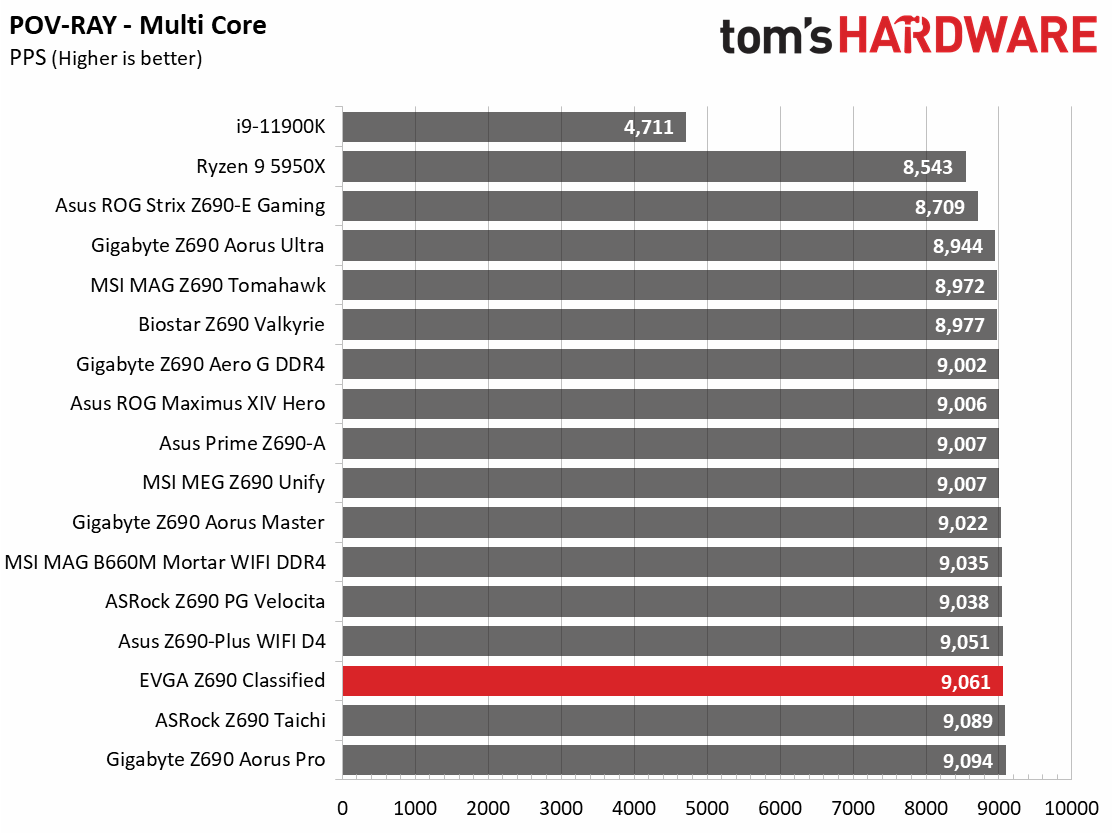

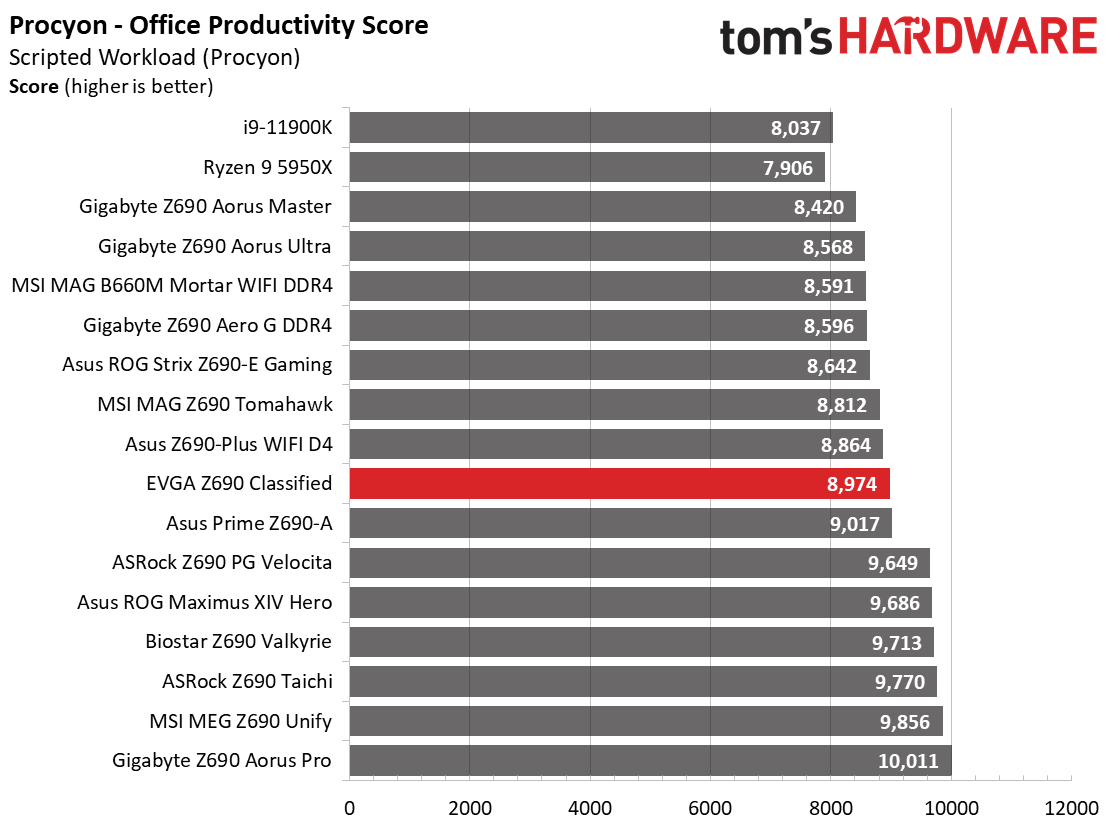
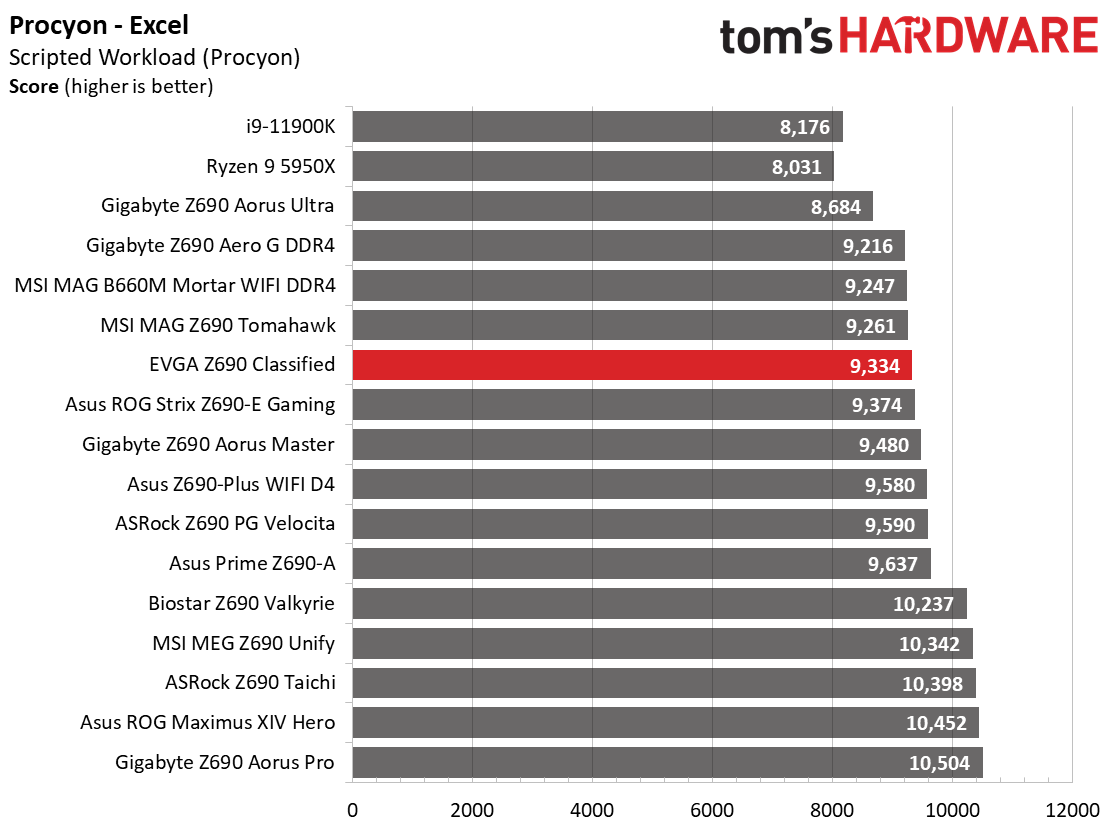
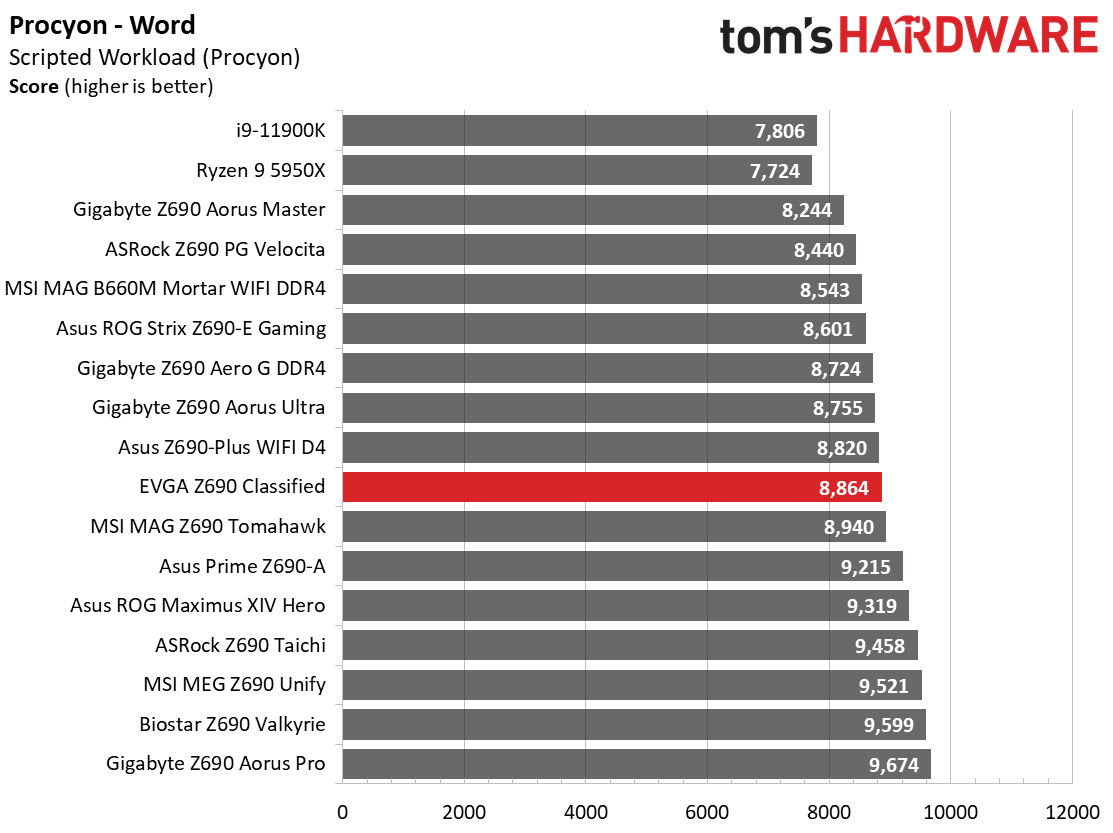
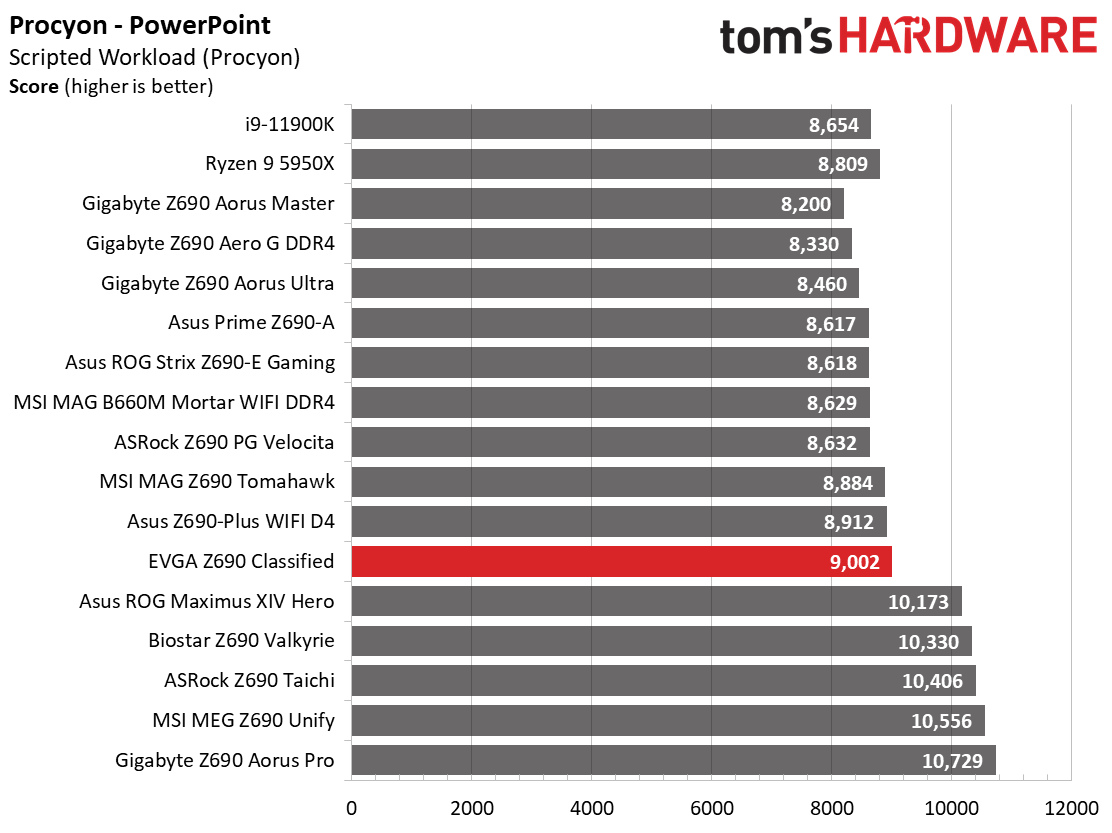
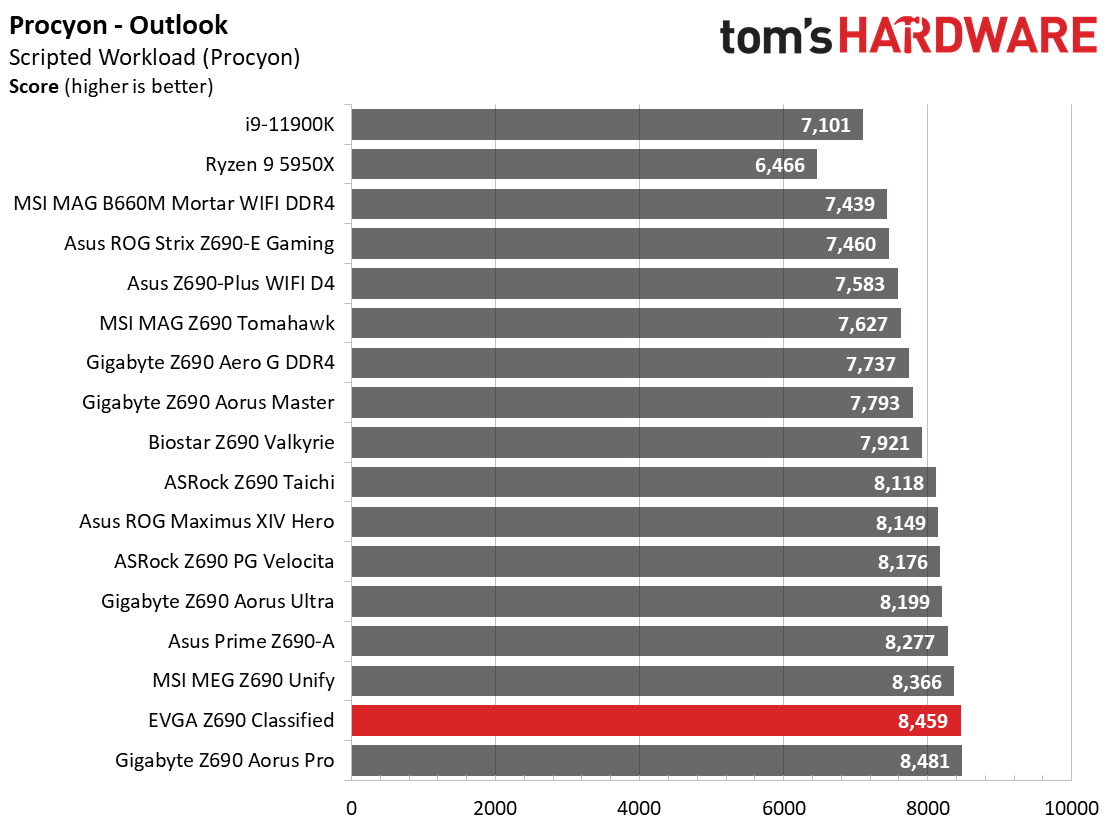
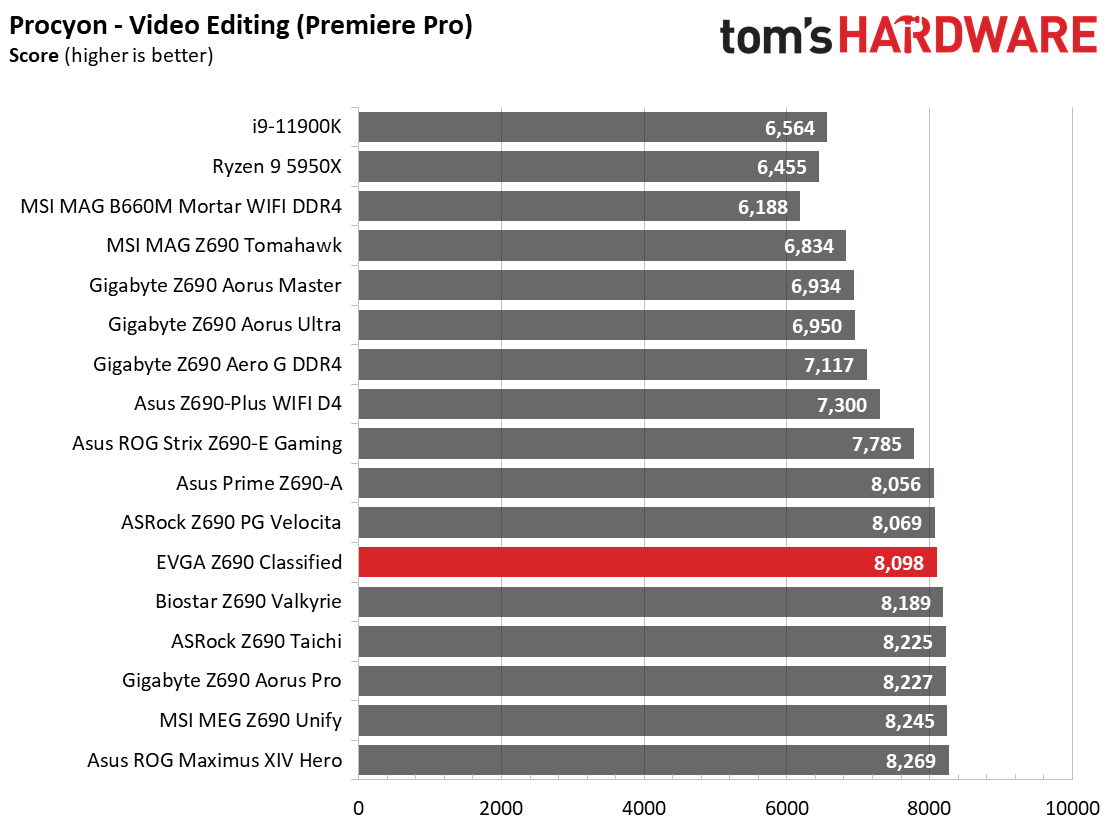
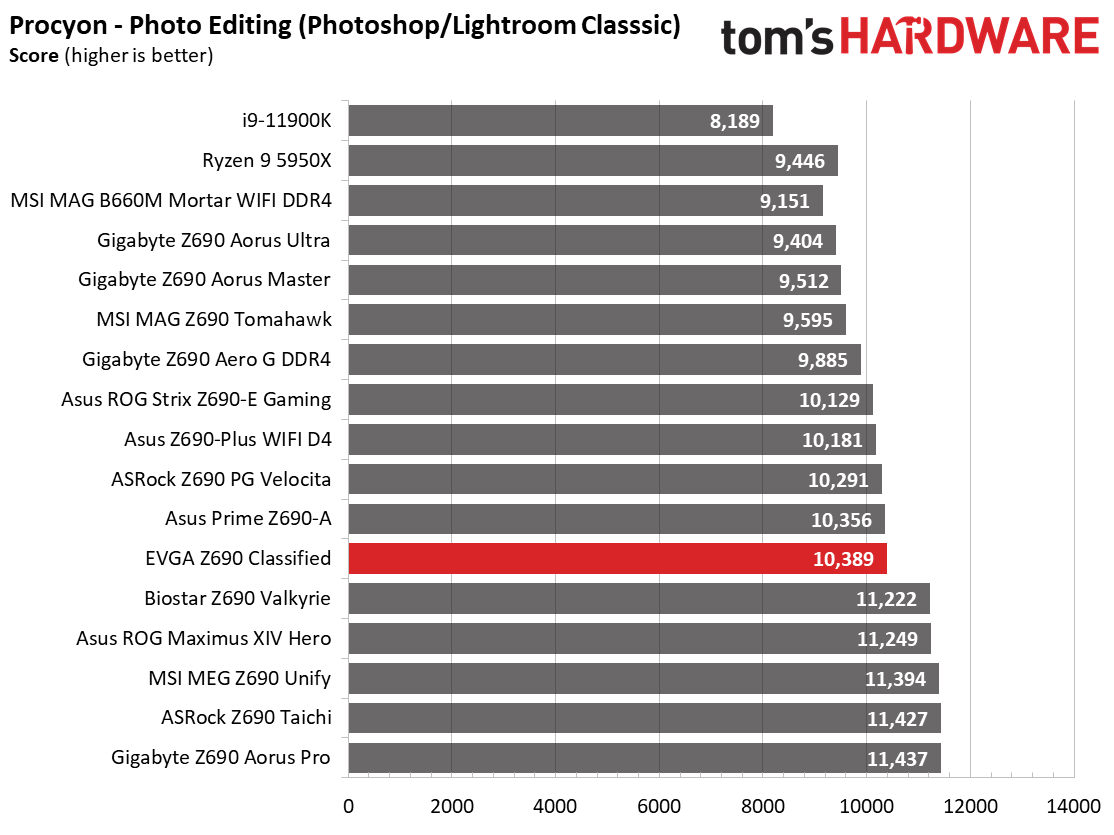
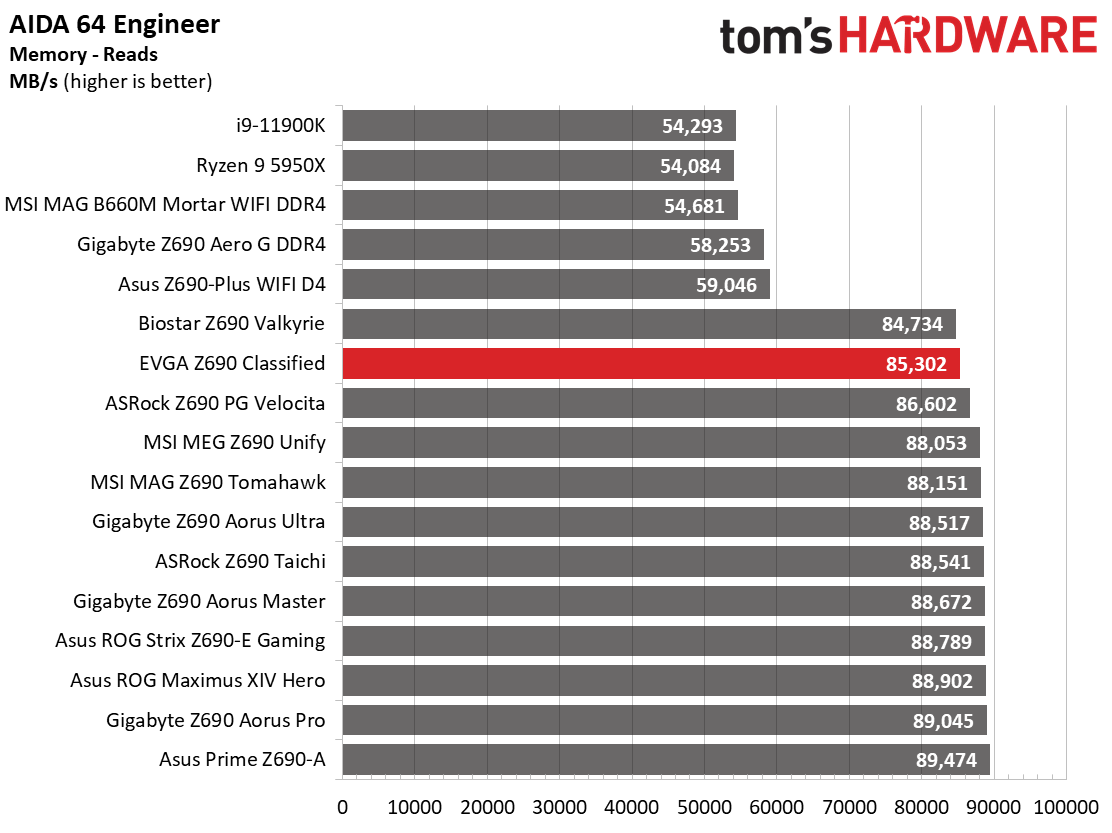
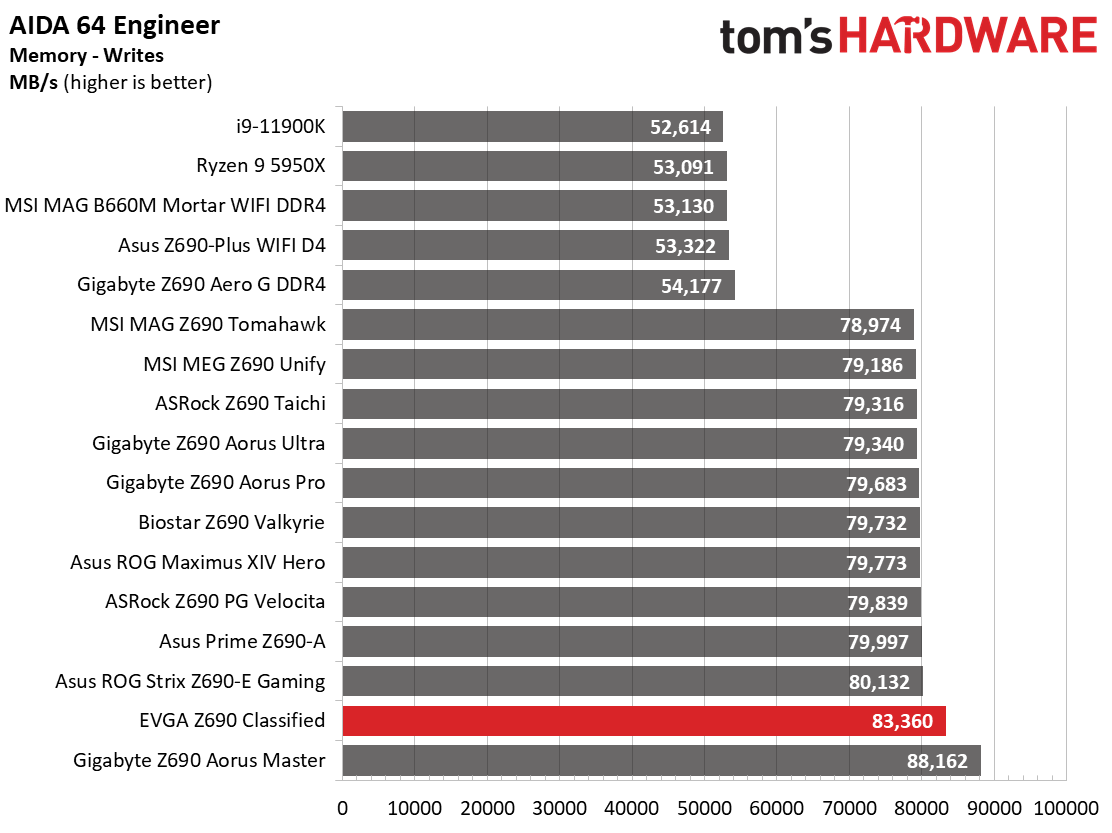
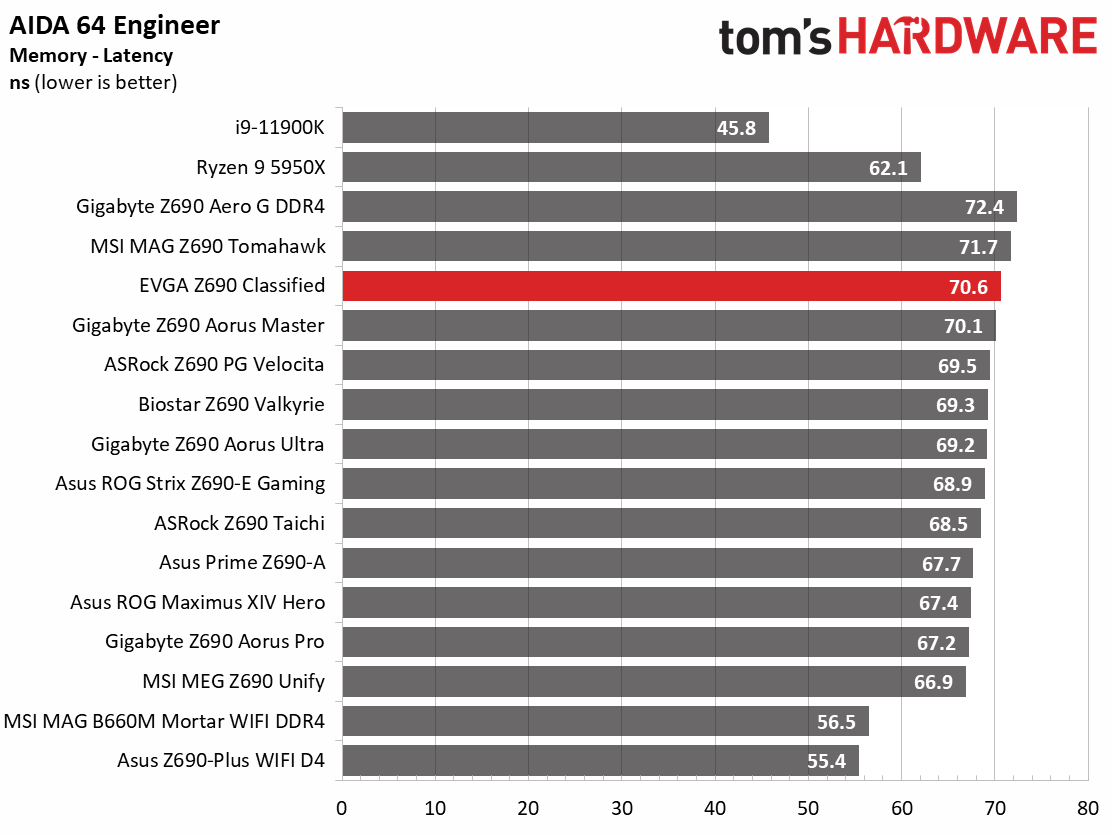
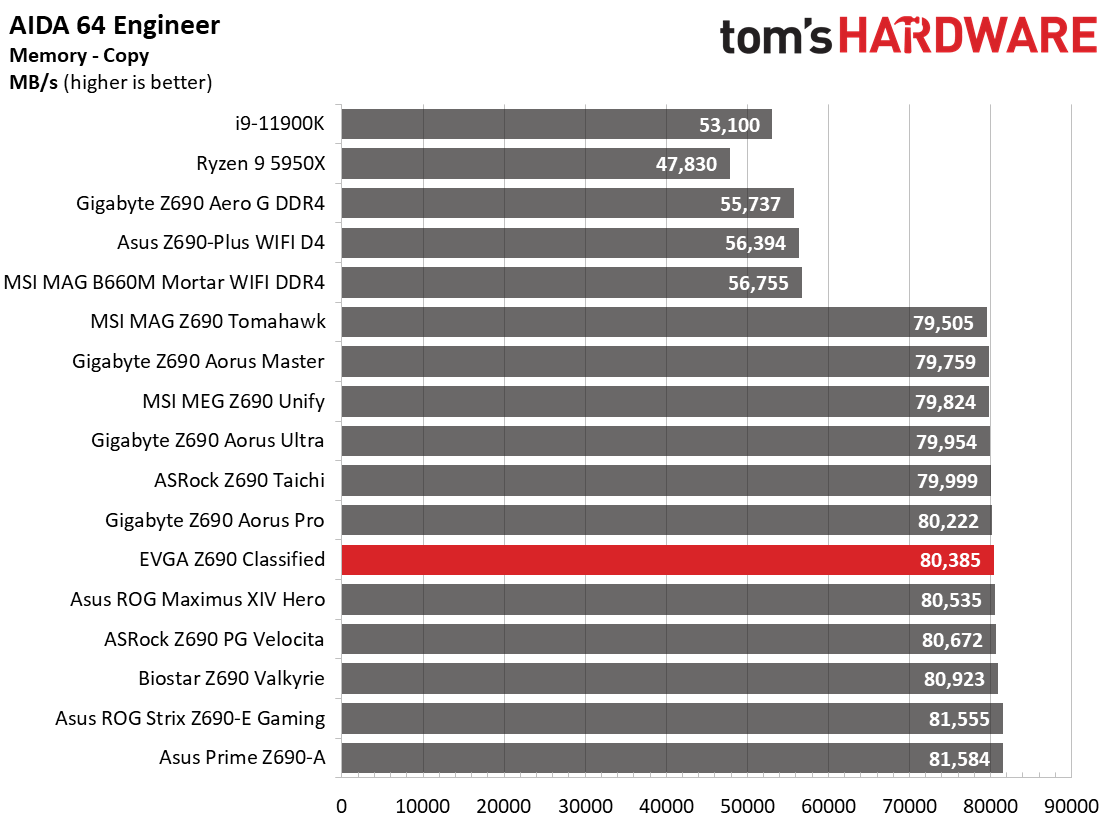
The Z690 Classified mixed in with the other DDR5-based Z690 boards we’ve tested so far. Nothing was the fastest nor the slowest, so performance in this set of applications was spot on what we’d expect.
Timed Applications
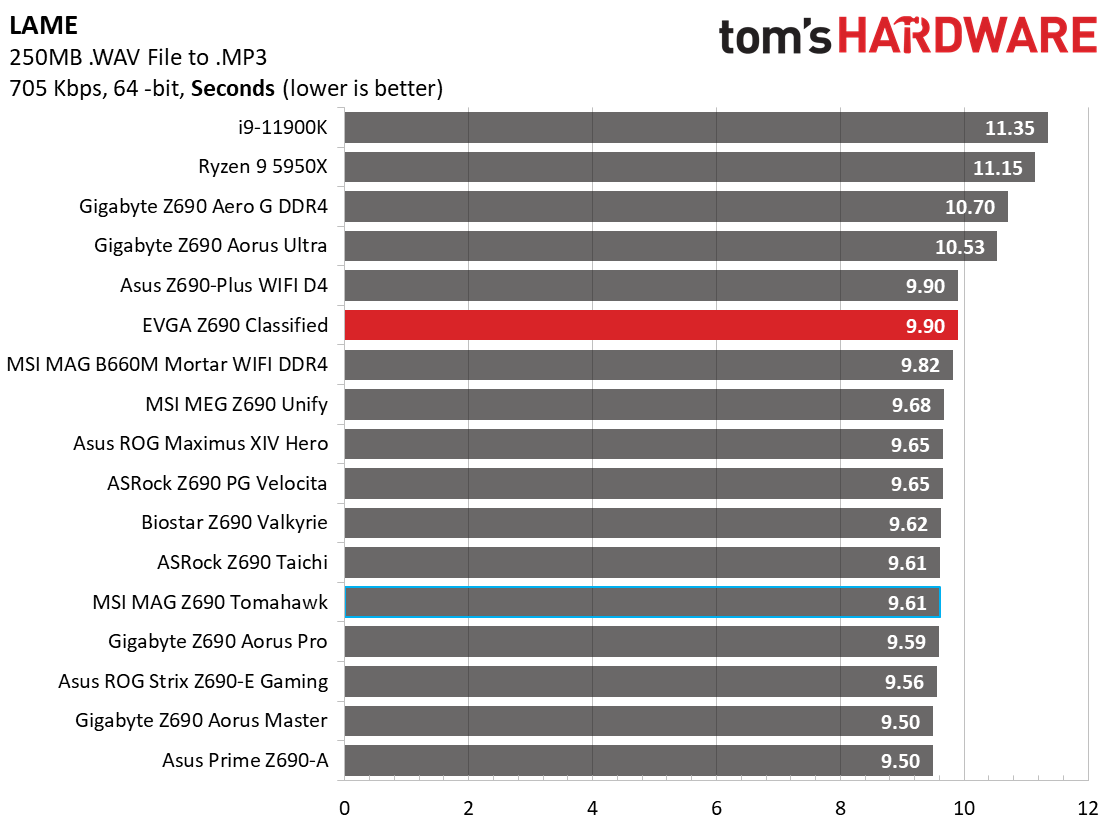
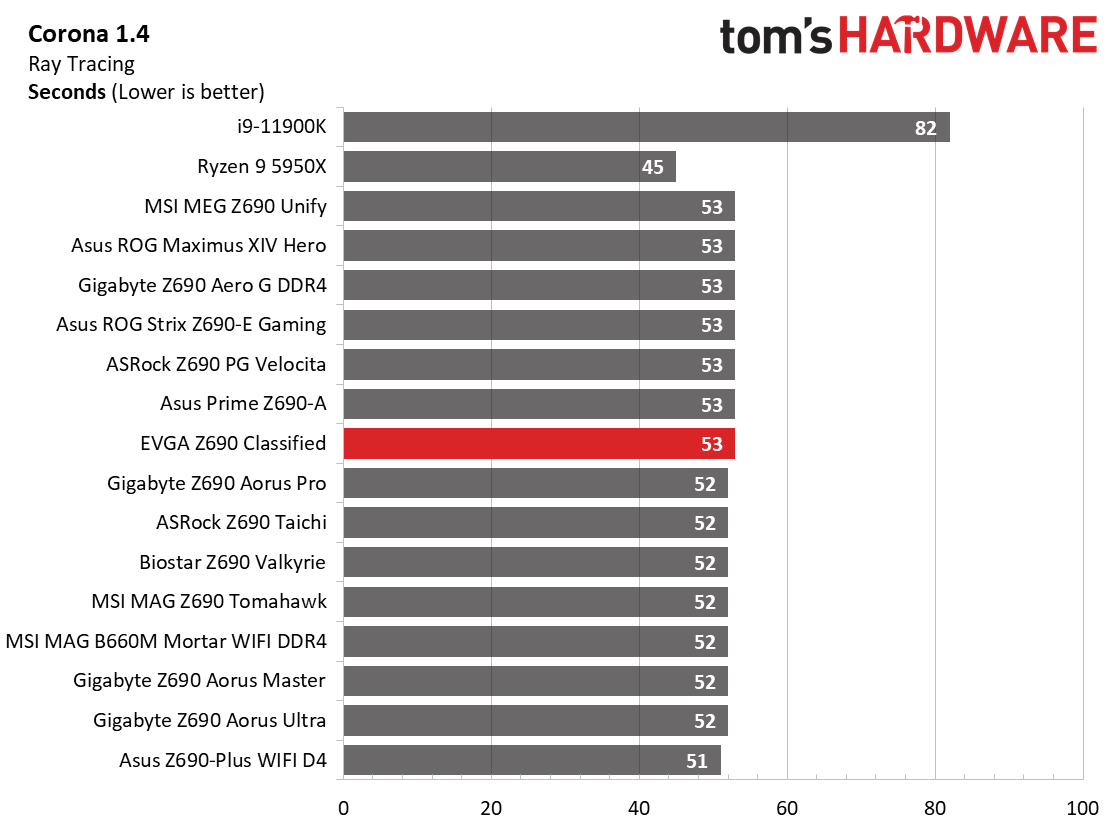
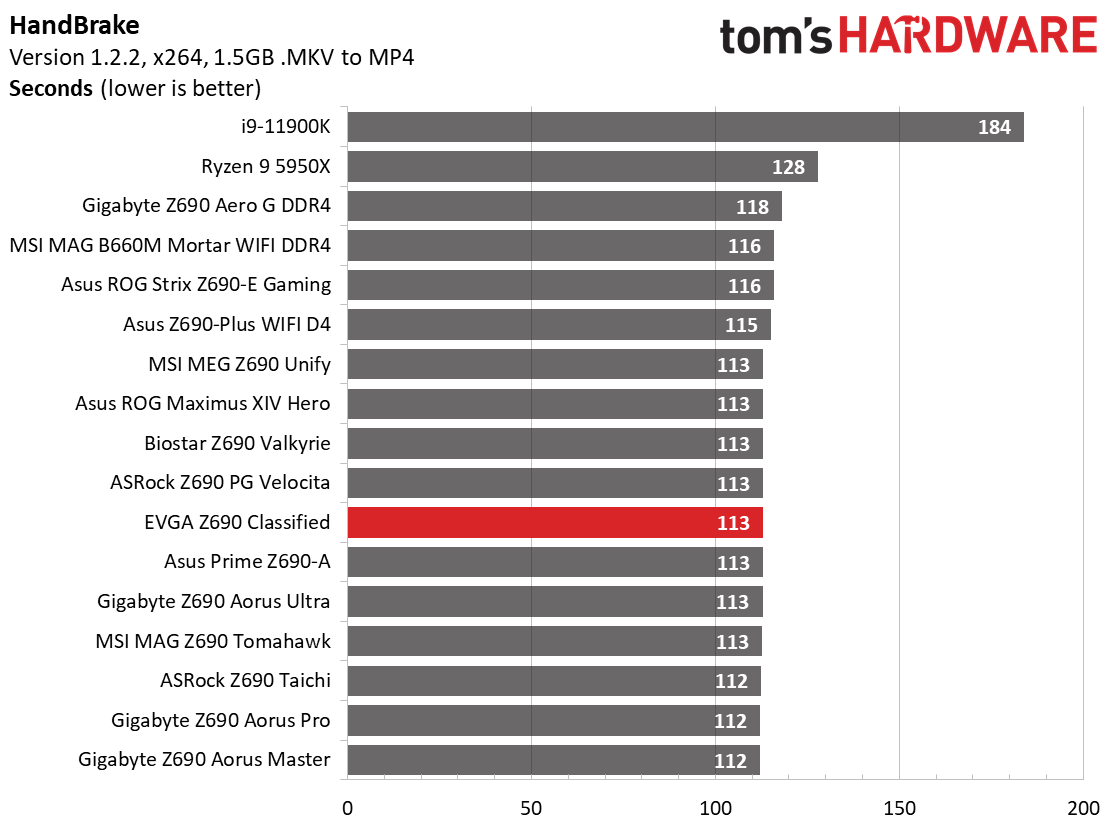
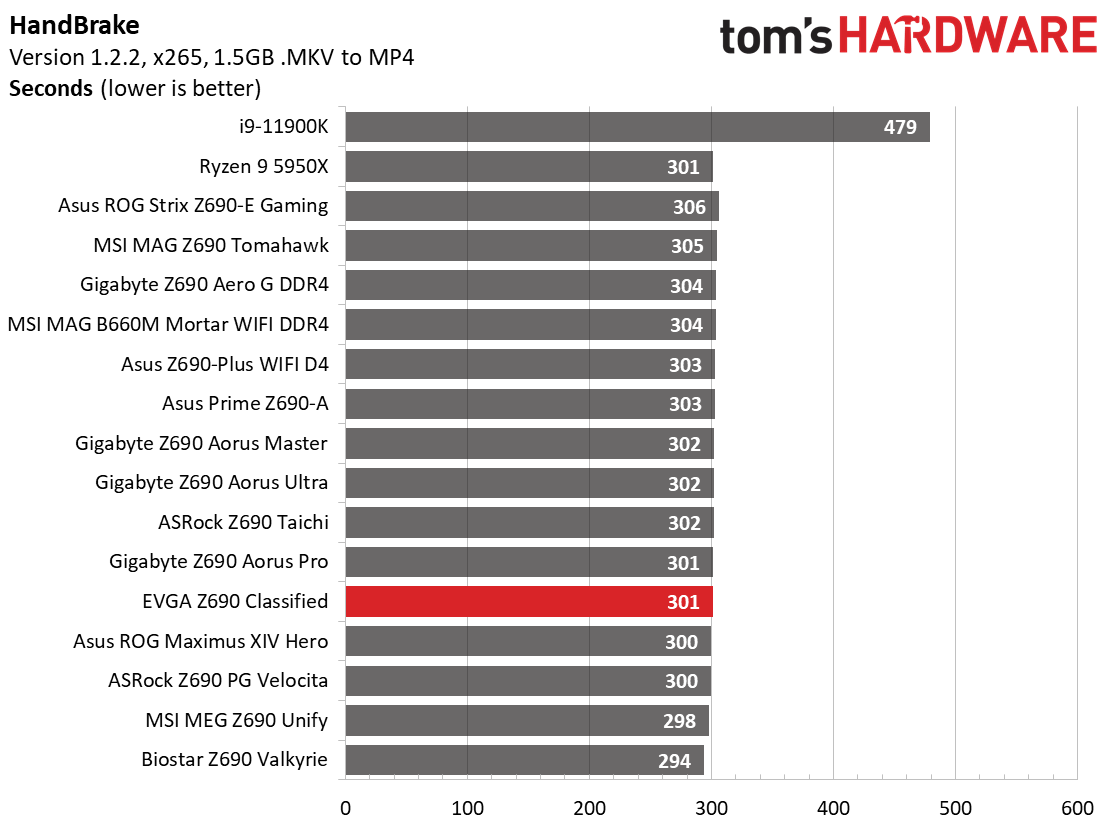
Starting with LAME testing, the Classified took 9.9 seconds to complete, one of the slower results that closely matched the DDR4 results. The difference between the fastest and slowest result is around 4% (9.50 to 9.9 seconds), so the variance isn’t huge, but still there. Corona testing was also slightly below average, completing the ray-tracing test in 53 seconds (average is 52 seconds, fastest is 51 seconds). Both Handbrake results were spot on average among the tested boards.
3D Games and 3DMark
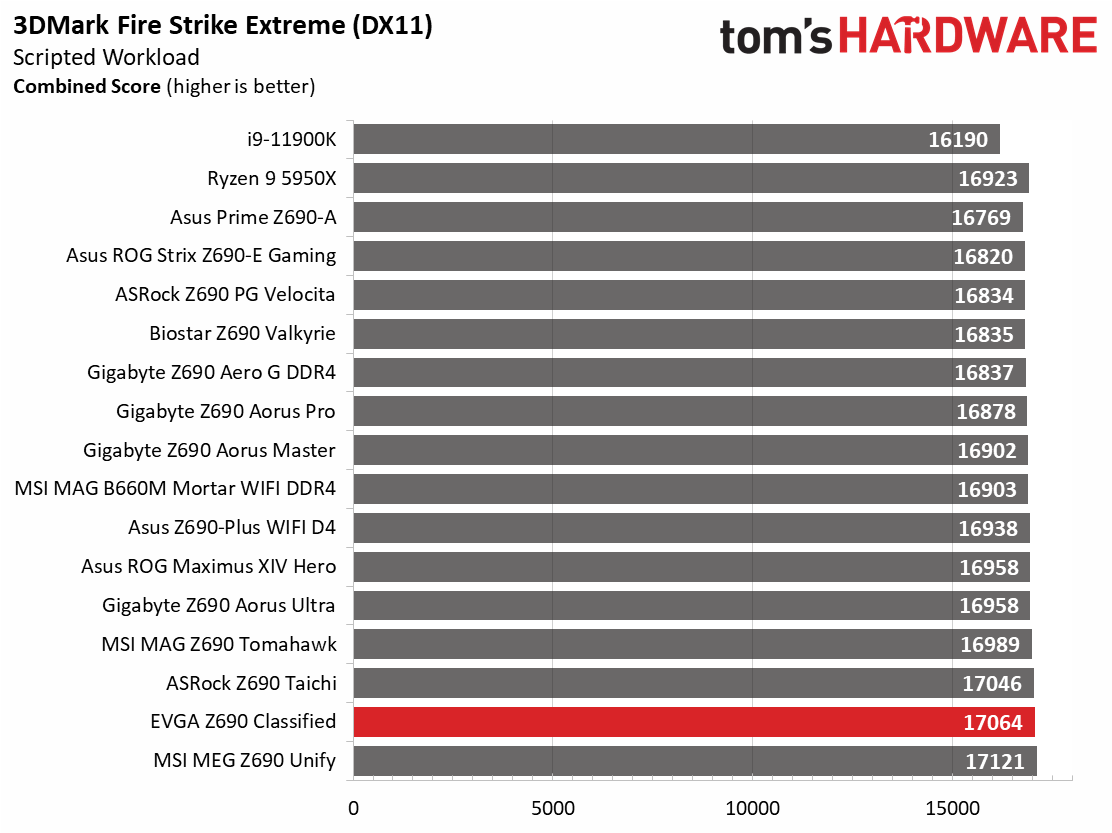
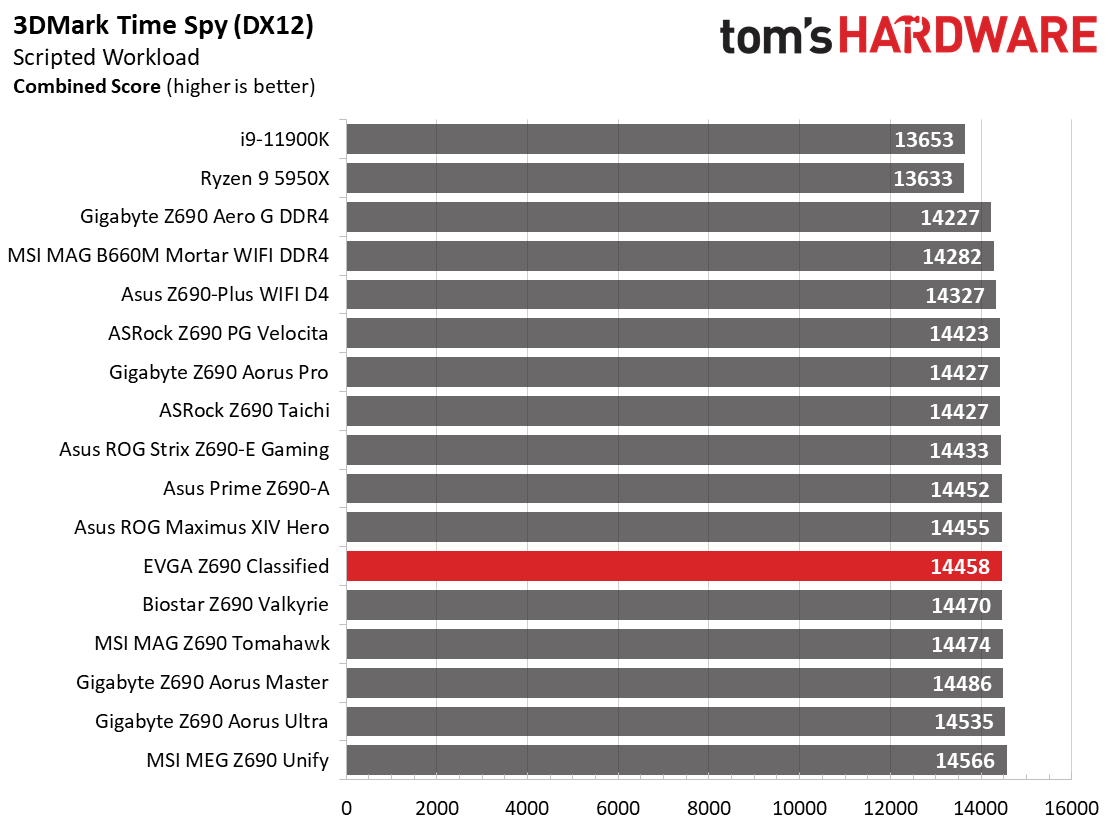
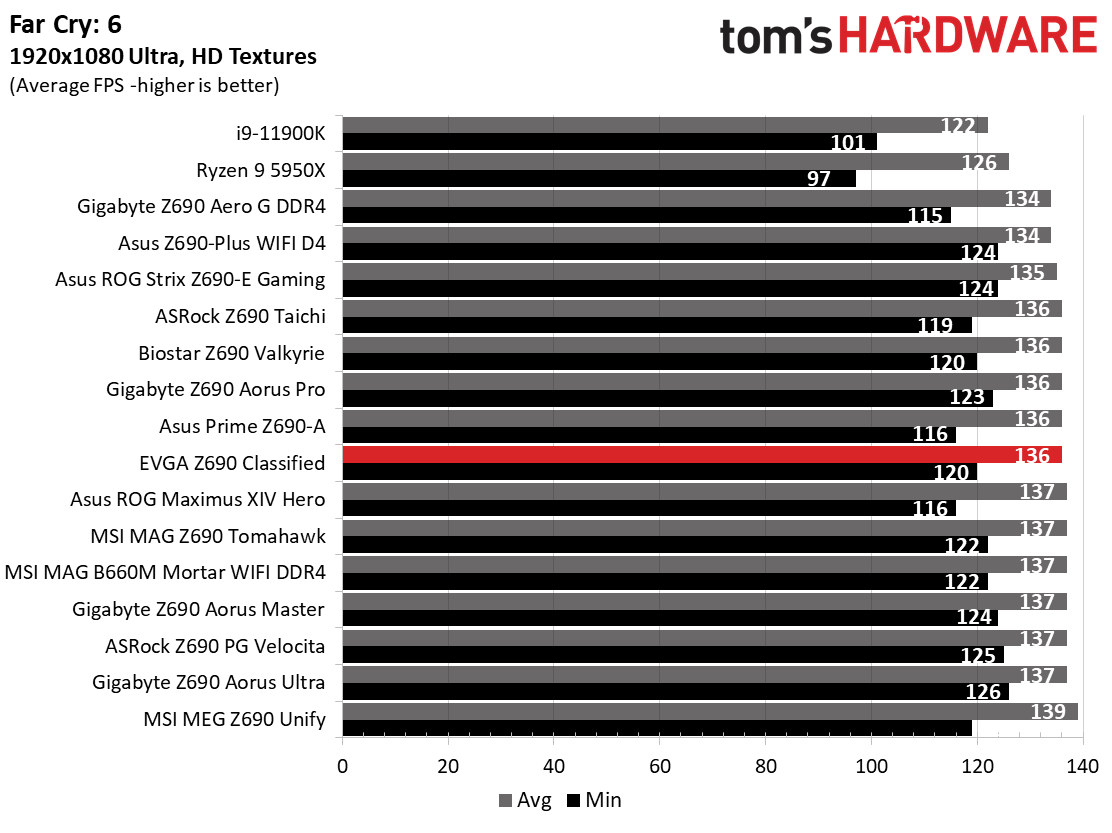
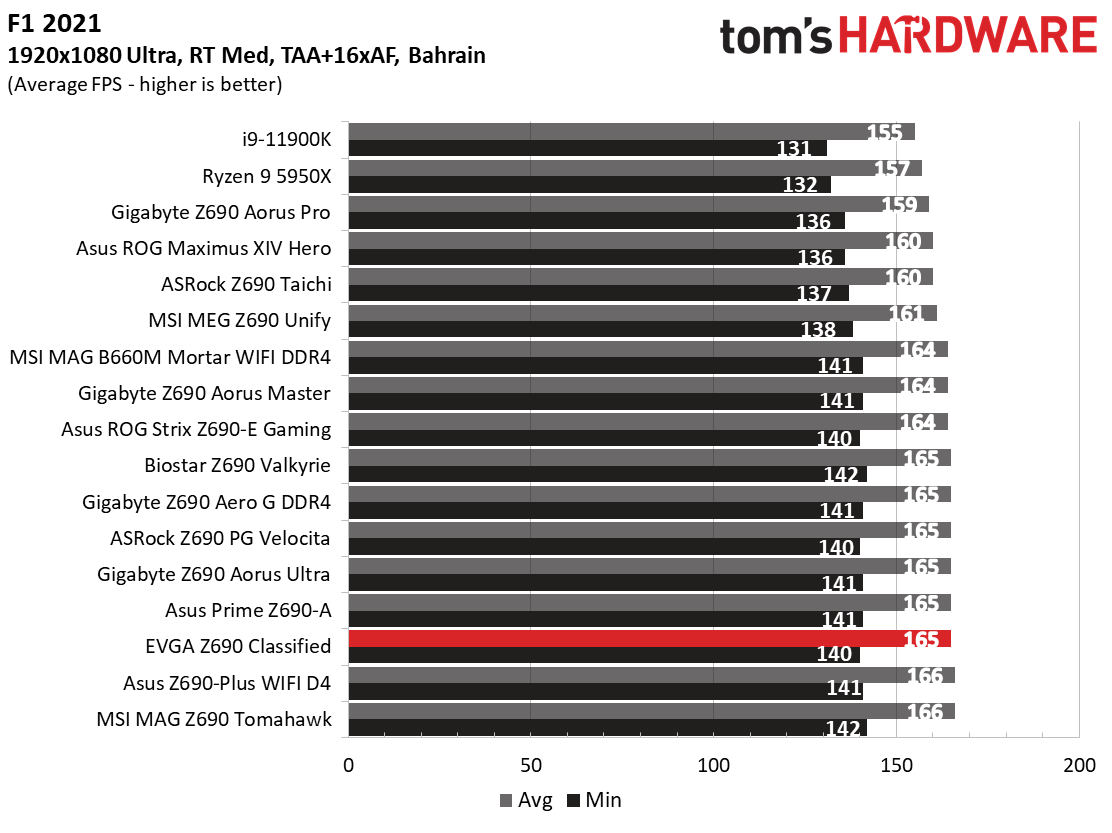
Starting with the launch of the Z690 chipset, we’ve updated our game tests. We’ve updated Far Cry: New Dawn to Far Cry 6 and shifted from F1 2020 to F1 2021. We run the games at 1920x1080 resolution using the Ultra preset (details listed above). As the resolution goes up, the CPU tends to have less impact. The goal with these settings is to determine if there are differences in performance at the most commonly used resolution with settings most people use or at least strive for. We expect the difference between boards in these tests to be minor, with most falling within the margin of error differences. We’ve also added a minimum FPS value, as that can affect your gameplay and immersion experience.
In F1 2021, the Z690 Classified averaged 165 fps with minimums of 140 fps, one of the faster sets of results so far. Far Cry 6 was similar in that the average fps matched our other results, but the minimum was a couple of frames slower than most at 120 fps.
Get Tom's Hardware's best news and in-depth reviews, straight to your inbox.
Our trend of not seeing significant differences among Z690 boards continues in our synthetic video card benchmarks. The Classified scored 14,458 on 3DMark Time Spy and 17,064 on Fire Strike Extreme, both of which are average to slightly above average. In short, you have nothing to worry about when gaming on this motherboard.
Power Consumption / VRM Temperatures
We used AIDA64’s System Stability Test with Stress CPU, FPU and Cache enabled for power testing, using the peak power consumption value. The wattage reading is from the wall via a Kill-A-Watt meter to capture the entire PC minus the monitor. The only variable that changes is the motherboard; all other parts are the same.
At idle, the Z690 Classified consumed 74W, which lands on the higher side of average. Load power use was also higher than average, peaking at 305W when running the typical 4/9/3.7 GHz default clock speeds. Overall, the Classified is just slightly over the average as far as power use goes. But as usual, it would be difficult to see the difference in your electric bill between these boards.
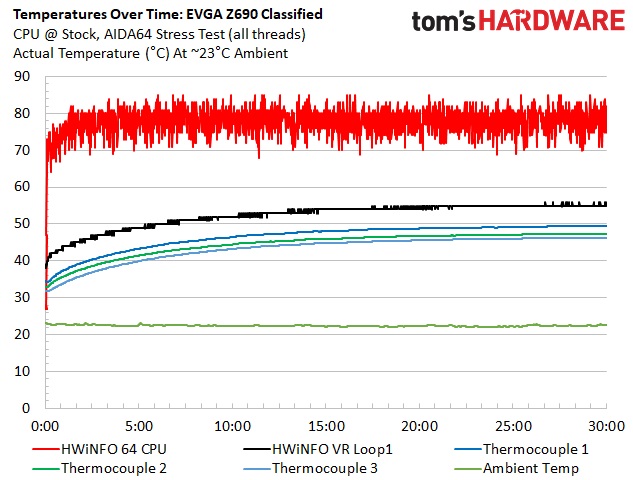
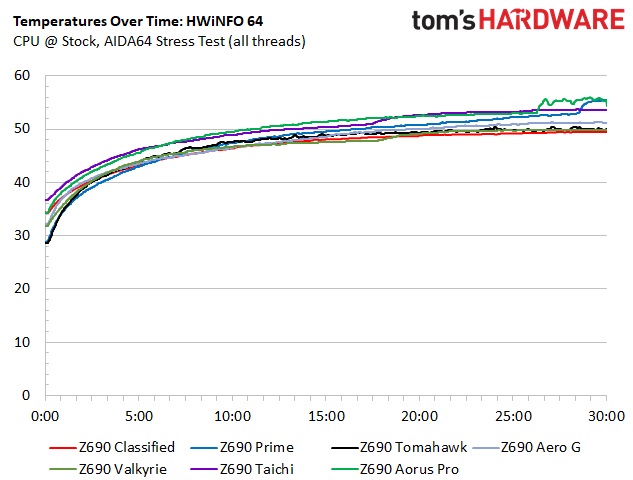
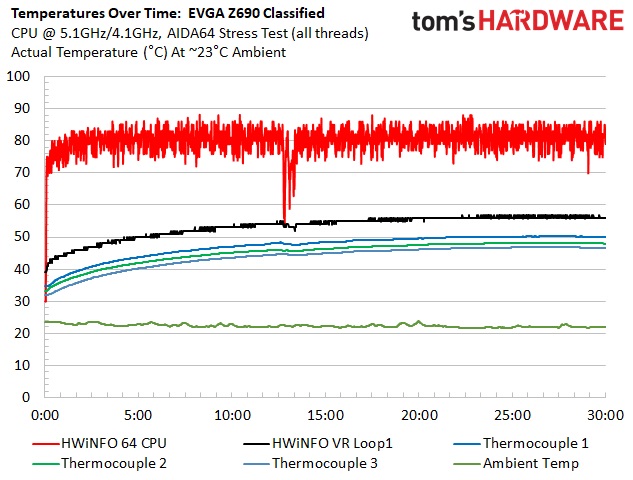
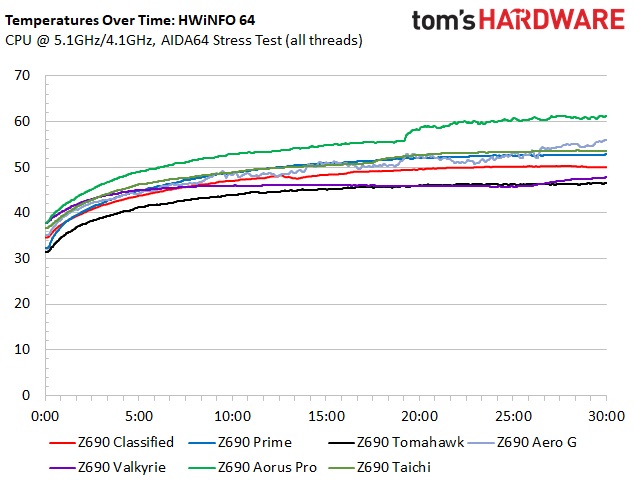
VRM temperatures on our Classified topped out at close to 50 degrees Celsius during stock testing and almost 52 degrees Celsius when overclocked. With the VRMs actively cooled, temperatures were lower than most others (that are passively cooled). Even when running stress tests, the fans are barely audible using default settings. You don’t need to worry about VRM temperatures at stock or while overclocked here.
Overclocking
Overclocking with Alder Lake is slightly different from what we’re used to due to the hybrid core configuration. Now, you can overclock the P and E cores separately, though they both use the same voltage domain. You can push one and not the other, or both, so there’s some flexibility. We set an overclock to 5.1 GHz across all P-cores and 4.1Ghz on all E-cores. This yields a 200 MHz bump on the P-cores and a 400 MHz increase on the E-cores. We’re topped out on the P-cores, primarily due to temperatures, but the more efficient E-cores still have some headroom.
Overclocking with the Classified and the flagship 8+8-core/24-thread i9-12900K proved painless. Since we’ve found our required voltage with our first review, we plugged in that 1.25V value for Vcore, adjusted LLC to “-50% Droop”, and tested it successfully. According to CPUz, the voltage was 1.32V, which seemed high for the temperatures and power the system was using. When moving to the EVGA Eleet X1 application, the reading was closer to 1.25V.
On the memory front, we set XMP, and off we went with our GSkill Trident Z5 DDR5 5600 CL36 Kit, yielding a 600 MHz increase from the maximum rating of the platform. After months of trying, we finally procured a DDR5 6000 kit to use while overclocking. With this ADATA kit, we set XMP, and off we went without issue.
Bottom Line
After our time with the EVGA Z690 Classified, we found it to be just as stable and speedy as any other motherboard we’ve tested so far. The BIOS arrived mature and handled our memory kits via XMP without issue. Features-wise, the motherboard has almost everything you need, including three M.2 sockets and eight SATA ports, robust power delivery, 2.5 GbE and Wi-Fi 6E, and last-gen flagship-class audio. Performance, including gaming, was average across the board, without anything reaching either extreme. In the end, we like what the new Z690 Classified brings to the table, including the updated appearance.
However, the board isn’t without its drawbacks. For a device over $600, I’d want to get everything Alder Lake offers, including a PCIe 5.0 M.2 socket. While we know it won’t take off for a while, you'll be forced to buy an add-in card (or buy another motherboard) when the time comes if you want to upgrade to a PCIe 5.0 x4 drive. Also, none of the M.2 sockets support SATA-based modules, which may be an issue if you have older M.2 drives that you might want to carry over to a new build. For most that won’t be an issue, but it’s a definite limitation that most competing boards don’t have. Last, I would like to see the latest Realtek audio codec, as other comparable boards bring that to the table.
Speaking of comparables, all major partners have a board somewhere around the Classified’s $629.99 price point. Asus has the ROG Maximus Z690 Hero ($599.99), MSI the MEG Z690 Ace ($599.99), ASRock Z690 Taichi ($589.99) and Gigabyte’s closest is the Z690 Aorus Tachyon ($549.99 - review coming soon). None of these boards include a PCIe 5.0 M.2 socket, but all have at least six SATA ports (ASRock has seven). The ASRock, like our Classified, runs with three M.2 sockets, while the other boards listed here have four or even five like the MSI MEG Ace. Power delivery on these competing boards will handle anything you can throw at them, even when using sub-ambient cooling methods. So none have a significant advantage there, regardless of the specifications. The best audio goes to the Asus and MSI boards that use the latest Realtek audio codec along with an additional DAC or Amplifier.
So if you’re looking to spend around $600 for your new Z690 motherboard, you can’t go wrong with any of the boards listed above. It will come down to your wants and needs, the appearance and price. The Classified is one of the more understated among this group as far as looks go, but it still looks the part of a premium motherboard. Considering the competition, I’d like to see the Classified priced at $599.99 (aren’t all motherboards a better deal cheaper?) but it’s still a sound option to build your Alder Lake-based system around.
MORE: Best Motherboards
MORE: How To Choose A Motherboard
MORE: All Motherboard Content

Joe Shields is a staff writer at Tom’s Hardware. He reviews motherboards and PC components.
-
Alvar "Miles" Udell ReplyAlong the right edge, we run into eight SATA ports, which is one area where this board has more than most of the competition. The Classified supports RAID0/1/5/10 modes for SATA if you’re looking for redundancy or striping (or both). In all, you can run all eight SATA ports and all three M.2 sockets concurrently (you just lose the bottom PCIe slot).
Am I the only one who just doesn't understand why 8 or even 6 SATA ports are included on motherboards, especially higher end motherboards, in 2022? If you're going to buy a $600+ motherboard, you likely have a pair or triplet, or even a quartet, of high capacity NVMe drives and probably don't have any SATA drives. Seems to me that bandwidth could be put to better use...
